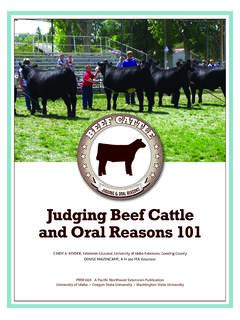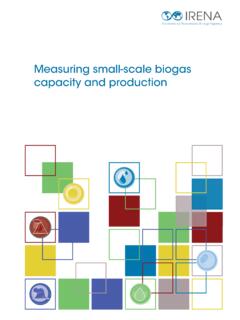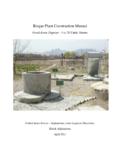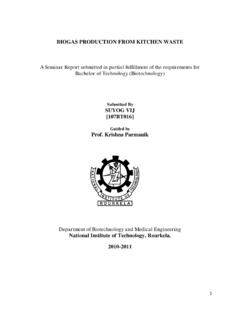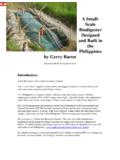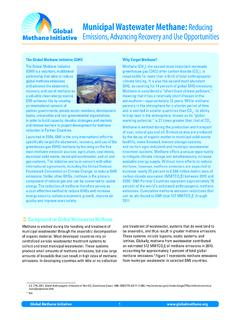Transcription of Anaerobic Digestion Basics - uidaho.edu
1 Introduction Dairy, potatoes, and sugar beets all importantagricultural commodities in Idaho also generate ahuge amount of wastes. Two big waste-relatedchallenges facing the dairy and food processingindustries are emissions of odors and gases andmanure management. Gas emissions includegreenhouse gases; ammonia (NH3), a colorless gas witha pungent smell; and hydrogen sulfide (H2S), acolorless gas with the foul odor of rotten eggs. Rising energy prices, more restrictive regulatoryrequirements, and increasing concern over greenhousegas emissions are causing many people in Idaho s dairyand food-processing industries to consider anaerobicdigestion (AD) of wastes from their Digestion technology is being viewed as away to address environmental concerns, generaterenewable energy, cut bedding-material costs, reducepathogens and weed seeds associated with manure,improve manure nutrient availability to plants , andsometimes generate new revenues.
2 What Is Anaerobic Digestion ? Anaerobic Digestion is a series of biological processesthat use a diverse population of bacteria to break downorganic materials into biogas , primarily methane, and acombination of solid and liquid effluents, the digestate(figure 1). It occurs in the absence of free materials are composed of organic compoundsresulting from the remains or decomposition of previouslyliving organisms such as plants and animals and theirwaste products. Sources of organic material for anaerobicdigestion include dairy manure, food processing waste,plant residues, and other organic wastes such as municipalwastewater, food waste, and fats, oils, and Digestion BasicsLide Chen and Howard NeiblingCIS 1215 Animal wasteDigester reactorHigh-quality, low-odor fertilizerElectricity generatorNatural gas pipelineElectricityHeatCow beddingOther organic wastesPure methaneMethane biogasH2S removalCO2 and impuritiesBiogasFigure 1.
3 Typical Anaerobic digester configurations. (Modified from feasibility. Original prepared by Sarah G. Lupis,Institute for Livestock and the Environment, Colorado State University.)The end product biogas is composed of methane (CH4,typically 60 70% by volume) and carbon dioxide (CO2,typically 30 40% by volume) as well as small amountsof H2S and other trace gases. biogas can be combustedto generate electricity and heat or processed intorenewable natural gas and transportation digested solids can be composted, utilized fordairy bedding, directly applied to croplands, orconverted into other products such as potting soil liquid, which contains fewer pathogens andweed seeds and is rich in crop nutrients, can be used asagricultural fertilizer.
4 Digestion of livestock manure alsoreduces emissions of greenhouse gases and odors. Benefits of Anaerobic DigestionThe following benefits are commonly recognized: Reducing odor missions, which improves air quality Harvesting biogas (mainly the greenhouse gasesCH4and CO2), which reduces greenhouse-gasemissions to the atmosphere Protecting water quality by reducing the potentialfor pathogens associated with manure to entersurface and/or groundwater Generating energy (gas, electricity, heat) that canbe sold for on-farm or off-farm uses Killing weed seeds in manure, which reduces costsof controlling weeds in fields Reducing bedding costs by using digested fiber Improving manure nutrient availability to plants ,reducing fertilizer costs Possibly receiving carbon credit payments Being a better Anaerobic DigestionProcessAnaerobic Digestion can be divided into four steps(figure 2).
5 Step 1. first step, hydrolysis, occurs asextracellular enzymes produced by hydrolyticmicroorganisms (for example, cellulase, amylase,protease, and lipase) decompose complex organicpolymers into simple, soluble monomers. Proteins arebroken down into amino acids, lipids into long- andshort-chain fatty acids, starch into glucose, andcarbohydrates into sugars. Step 2. small molecules resultingfrom hydrolysis are converted by acidogens(fermentative bacteria) to a mixture of volatile fattyacids (VFAs) such as acetic, propionic, and butyricacids and other minor products such as hydrogen,carbon dioxide, and acetic acid. Acidogenesis is usuallythe fastest step in the Anaerobic conversion of complexorganic matter in liquid-phase 3.
6 The third step, acetogenicbacteria further convert the volatile fatty acids toacetate, CO2, and/or hydrogen (H2).Step 4. Methanogenesis. Step 3 provides substratesfor methanogenesis, the last step in the anaerobicprocess for methane stable Anaerobic Digestion process requiresmaintaining a balance between several microbialpopulations. The hydrolysis and acidogenesis steps havethe most robust microbes (acid formers), which thrive inthe broadest environmental range. They react quickly toincreased food availability, so the fatty acidconcentration could rise very quickly. The pH range ismaintained under normal circumstances by the bufferingaction of the system provided by CO2in the form ofbicarbonate (HCO3-) alkalinity.
7 However, if the acidconcentration overcomes the system s buffering capacity,the pH value could be out of the acceptable limits of theacetogenic and methanogenic bacteria (methaneformers). When this happens, methane production stopsand the acid levels rise to the tolerance level of the acidformers, thus resulting in system , fats, proteinsSugar, fatty acids, amino acidsVolatile fatty acidsAcetic acid, hydrogen, carbon dioxideMethane, carbon dioxideHydrolysisAcidogenesisAcetogenesi sMethanogenesisFigure four-step Anaerobic Digestion addition to pH, temperature is a critical factoraffecting the balance between these microbialpopulations. Sudden changes in temperature adverselyaffect the methane formers, thus affecting the acidformers, too.
8 Any change having an adverse effect on themethane formers increases acid concentration, which inturn reduces the activities of the methane manure and many other substrates includingfood processing wastes such as cheese whey, yogurtfactory wastewater, sugar beet processing wastewater,and fruit and vegetable wastes are commonly usedfeedstocks. Feedstock characteristics are important factorsaffecting biogas production and process stabilityduring Anaerobic Digestion . The main characteristics offeedstocks include moisture content, total solids (TS),volatile solids (VS) (organic compounds of plant oranimal origin that are lost on ignition of the dry solidsat 550 C [1022 F]), particle size, pH, biodegradability,chemical oxygen demand (COD), biological oxygendemand (BOD), and carbon and nitrogen contents.
9 Theconcentration of volatile fatty acids and NH3, both ofwhich could cause toxicity and process failure at highconcentrations, is largely dependent on feedstockcharacteristics and loading 1 shows the characteristics of lactating dairy cowmanure and its biogas Operating FactorsAffecting Anaerobic DigestionTemperatureTwo distinct temperature ranges are most suitable forbiogas production, and different bacteria operate ineach of these ranges. Mesophilic bacteria optimallyfunction in the 90 F to 110 F range. Thermophilicbacteria are most productive in the 120 F to 140 Frange. Thermophilic Digestion kills more pathogenicbacteria, but the cost to maintain a higher operatingtemperature is greater. Thermophilic digesters mayalso be less Digestion in covered lagoons at temperaturesbelow 90 F is called psychrophilic.
10 Psychrophilic meansa preference for lower temperatures; however, digestionslows down or stops completely below 60 F or 70 F, sothese digesters do not produce methane all of the within the digester is critical, withmaximum conversion occurring at approximately 95 Fin conventional mesophilic digesters. For each 20 Fdecrease in temperature, gas production falls byapproximately 50%. Even more significant is the needto keep the temperature steady since the methaneformers are temperature sensitive. Hydraulic retention time and loading rateHydraulic retention time(HRT), the average time thata given volume of sludge stays in the digester, is one ofthe most important design parameters affecting theeconomics of a digester.





